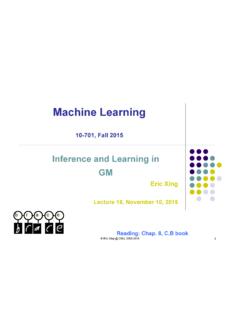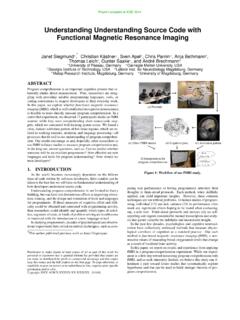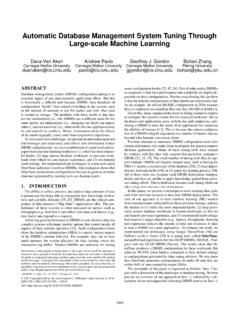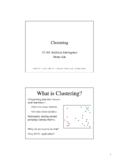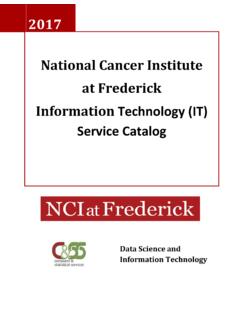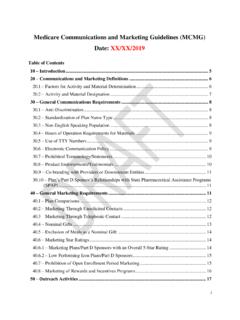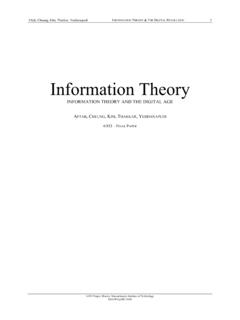Transcription of 2 Information and Communications Technology (ICT)
1 19 The 4Cs of ICT: Computing, Connectivity, Content, and (human) Capacity Together, ICT is roughly of the world s GDP ICT is more than computers and telephony ICT is embedded in virtually all industrial, commercial, and services systems ICT is a fundamental part of economic growth, especially for the so-termed knowledge economy 2 Information and Communications Technology (ICT) Overview The International Telecommunications Union (ITU) estimates the worldwide ICT market in 2002 was almost $ trillion, which they segmented as Telecom Services (39%), Software and Services (31%), and Hardware (30%). This comes to nearly of the Gross World Product. Surprisingly, in developing countries, ICT s share in GDP is not low.
2 ICT can be considered to be built on the 4 C s Computing, Communications , Content, and (the often overlooked) human Capacity. The recent World Summit on the Information Society (WSIS) focused extensively on 3 Cs, Communications , content, and capacity building, and less so on computers. In truth, computing and other hardware continue to become less and less expensive, especially on a price-performance basis. When considering the use of ICT for development, conventional wisdom is that even if hardware is free ( , donated), Communications , software, and training make ICT expensive. ICT is much more than computers and the Internet or even telephony, even though the digital divide and issues of Internet governance were much of the focus of WSIS.
3 Applications of ICT can be divided under two broad categories. The first are those largely dependent on traditional telecommunications networks (including the Internet) that enable on-demand Communications to provide Information tailored to the user s convenience and needs. How that Information is processed, whether it is used at all, and whether it is transformed into knowledge is left to the human user who asked for that Information in the first place. The second group of ICT applications, for want of a more appropriate name, we shall call Human Independent, where Information is processed and decisions are arrived on the basis of preset criteria without human intervention at the time of decision making.
4 These can be nearly passive systems, or part of a larger system (embedded ICT). Examples include sensor-based networks that determine automated climate control for buildings today, or, in the near future, sensor networks for malarial larvae detection. Many of the more-discussed applications of ICT for SD are of the first category, ranging from distance education programs, e-commerce, or e-governance, while the second class of applications remains largely unrealized. A major challenge is how to design both ICT and other complex engineering or societal systems such that the two can be integrated. ICT and Development Information and Communications Technology (ICT) is viewed as both a means and an end for development.
5 With roughly two-third of the world economy based on services, and the rise of India, Philippines, and other nations as global IT players, many developing countries have accepted ICT as a national mission. Even within manufacturing and industry, ICT has an increasingly important role to play. During 1995 2002, when the US economy posted impressive overall growth, nearly one-third of the growth in productivity was attributable to 20 ICT for Sustainable Development: Defining a Global Research Agenda While the growth rates of ICT even in developing countries are impressive, the base upon which these apply is very low. John Daly, in a series of articles,4 discusses point by point how ICT can work to meet the eight goals identified with the 18 targets set by the MDGs.
6 Similar options are indicated in World Bank publications (such as Footnote 1) and in the World Telecommunication Development Report 2003, excerpted in Table 1. Allocation of resources to an MDG sector and ICTA llocation of resources to ICT in the sectorAllocation of resources to the sectorICT-related increased efficiency in deliveringNon ICT-related increased efficiency in deliveringIncreased efficiency in delivering in the sectorImpact on this MDG sectorAllocation of resources to an MDG sector and ICTA llocation of resources to ICT in the sectorAllocation of resources to the sectorICT-related increased efficiency in deliveringNon ICT-related increased efficiency in deliveringIncreased efficiency in delivering in the sectorImpact on this MDG sector Source: Lanvin and Qiang (2003)5 Figure 2: ICT and Development.
7 Resource Allocation and Impact in MDG Sectors 3 There are different estimates on the growth and role of ICT, both within ICT sectors and in ICT consuming sectors. These estimates are from the 2003 Economic Report of the President, and are the growth of productivity after 1973-1995 after accounting for cyclical business effects. 4 5 Lanvin and Qiang (2003). Chapter Poverty E-readication : Using ICT to Meet MDGs: Direct and Indirect Roles of E-Maturity in Dutta, Lanvin and Paua, ed., Global IT Report 2003-04 Oxford University Press. Information and Communications Technology (ICT) 21 Goal/Target Role of ICTs 1. Eradicate extreme poverty and hunger Halve, between 1990 and 2015, the proportion of people whose income is less than one dollar a day Halve, between 1990 and 2015, the proportion of people who suffer from hunger Increase access to market Information and reduce transaction costs for poor farmers and traders Increase efficiency, competitiveness and market access of developing country firms Enhance ability of developing countries to participate in global economy and to exploit comparative advantage in factor costs (particularly skilled labor) 2.
8 Achieve universal primary education Ensure that, by 2015, children everywhere, boys and girls alike, will be able to complete a full course of primary schooling Increase supply of trained teachers through ICT-enhanced and distance training of teachers and networks that link teachers to their colleagues Improve the efficiency and effectiveness of education ministries and related bodies through strategic application of technologies and ICT-enabled skill development Broaden availability of quality educational materials/resources through ICTs 3. Promote gender equality and empower women Deliver educational and literacy programs specifically targeted to poor girls and women using appropriate technologies Influence public opinion on gender equality through Information or communication programs using a range of ICTs.
9 4. Reduce child mortality 5. Improve maternal health 6. Combat HIV/AIDS, malaria, and other diseases Reduce infant and child mortality rates by two-thirds between 1990 and 2015 Reduce maternal mortality rates by three-quarters between 1990 and 2015 Provide access to all who need reproductive health services by 2015 Enhance delivery of basic and in-service training for health workers Increase monitoring and Information -sharing on disease and famine Increase access of rural caregivers to specialist support and remote diagnosis Increase access to reproductive health Information , including Information on AIDS prevention, through locally appropriate content in local languages 7. Ensure environmental sustainability Implement national strategies for sustainable development by 2005 so as to reverse the loss of environmental resources by 2015 Halve, by 2015, the proportion of people without sustainable access to safe drinking water Have achieved, by 2020, a significant improvement in the lives of at least 100 million slum dwellers Remote sensing technologies and Communications networks permit more effective monitoring, resource management, mitigation of environmental risks Increase access to/awareness of sustainable development strategies, in areas such as agriculture, sanitation and water management, mining, etc.
10 Greater transparency and monitoring of environmental abuses/enforcement of environmental regulations Facilitate knowledge exchange and networking among policymakers, practitioners and advocacy groups Source: Table , World Telecommunication Development Report 2003 (ITU) [Reproduced with the kind permission of ITU] Table 1: How ICTs can help the MDGs 22 ICT for Sustainable Development: Defining a Global Research Agenda ICT can help achieve the MDGs by: increasing efficiency, transparency, and competitiveness; opening up new opportunities and business models; and empowering citizens WSIS Phase I Targets largely deal with ICT infrastructure As Table 1 and Figure 2 show, ICT will not directly realize the Millennium Development Goals (MDGs).
